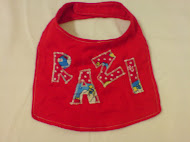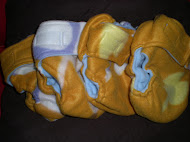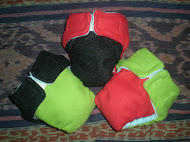Sources: Vertel's
Definitions of Terms in Conjunction with Fleece
Absorption: The fabric's process of pulling moisture into the fibers, not necessarily keeping moisture away from baby's skin.
Breathability: Measured by the amount of water vapor which can be transmitted through a fabric.
MicroFibers: Very thin, synthetic fibers made of polyester, nylon and acryllic; wicking, quick-drying and water resistant if tightly woven.
Moisture Transfer: The movement of moisture from baby's skin into and through wicking fibers to the outermost layer of the fabric where moisture is dispersed across its surface in order to evaporate.
Wicking Properties: The ability of a fabric to transfer (or 'pull') moisture through itself and away from baby's skin to the outside/exterior.
Wicking: The transfer of moisture (baby's urine) through fabric to outside surface for absorption or evaporation.
What is so great about fleece...
by Heather L. Sanders
www.ohmystinkinheck.com
Fleece . . . it seems to be the 'newest' rage in the cloth diapering industry. In only two years, fleece-made cloth diapering products have grown to new heights in the cloth diapering community and now, most cloth diapering moms are taking advantage of the many wonderful qualities of fleece for their babies.
So, let's talk about this performance fabric, fleece:
- What exactly is fleece anyway?
- What are its wonderful qualities?
- Why fleece instead of Cotton or Wool?
- Is there a difference in fleece products?
What exactly is fleece anyway?
Fleece is basically a synthetic, 100% polyester fabric with an altered 'structure.' This altered 'structure' facilitates moisture transfer through the fabric - some will say 'absorb' through the fabric. Polyester fabric, in and of itself, does not absorb moisture at all.. Instead fleece wicks moisture away from the skin to its outer surface where it can do one of two things:
- Spread out and evaporate if exposed to air.
- Absorb into another fabric-usually a cotton 'soaker' of some sort.
What are fleece's wonderful qualities?
Attributes of fleece that are often promoted are that fleece is:
- Highly breathable.
- Lightweight (though it can be purchased in mid weight)
- Pill-resistant.
- Hardy and can withstand industrial washing/drying
- Virtually stain-proof.
- Easy to care for and clean.
- Great for color retention..
- A fast drying fabric.
- Chlorine-resistant.
- VERY SOFT and COMFY!
Why fleece instead of just cotton or wool?
First, even though both Wool and Cotton are porous, they will still absorb and 'hold' water. Cotton NEVER wicks when wet. Cotton absorbs moisture and has absolutely NO wicking properties.
So, this means that once cotton becomes wet or saturated it will STAY WET and keeps baby's skin wet and clammy as well. In the winter, it will make baby cold. In the summer, it will make baby hot.
Okay, so why not WOOL then?
First, it is heavier in weight than fleece and therefore, takes longer to dry. AND it absorbs the moisture, instead of wicking the moisture to the exterior surface or to an inner 'soaker' (as fleece does), so the moisture does not get as much opportunity to evaporate dry. Cotton, as we said before, will NEVER wick when it gets wet. Because cotton gets wet and stays wet, it sticks to baby's skin and this hinders the evaporation process of moisture transfer. Evaporation of moisture is important to keep baby's temperature at an appropriate level - keeping them cool. The Micro Fibers in Fleece allow for the cooling process by 'wicking' the baby's urine away from his/her skin. Is there a difference in fleece products? Absolutely!
Do not be fooled into thinking that all fleece is the same - it is not.
A good fleece to look for is called Polar Fleece. Polar Fleece is a high quality performance fabric first developed by Malden Mills in the 1970s. Several companies make Polar Fleece now, but be certain that you are getting quality - there are lesser quality varieties that won't work as well for diaper covers or liners.
Fleece functions much like wool, in that it is breathable and it wicks, but it does not have the added bulk, weightiness, is easier to care for and clean and is much more soft and comfy for baby.
source from http://diaperpin.com/
__________________________________________________________________


























0 comments:
Post a Comment